The Vietnam War was fought between communist North Vietnam and the government of Southern Vietnam. The North was supported by communist countries such as China and USSR. The South was supported by anti-communist countries, primarily the United States or, in other words, Capitalism vs. Communism. The United States Joined the war on March 8, 1965, when the first American combat troops – the 9th Marine Expeditionary Brigade – waded ashore at China Beach north of Da Nang. However, United States lost the Vietnam War, which lasted for twenty years. During the war in Vietnam, the American military gave the press unprecedented freedom of access to combat zones, which helped reporters and photographers to document the war. Between 1962 and 1975, military photographers took millions of photographs of the American conflict in Vietnam. These photographs serve publishers, historians, and students who want to learn more about Vietnam. They include images of almost every aspect of the war.
#1
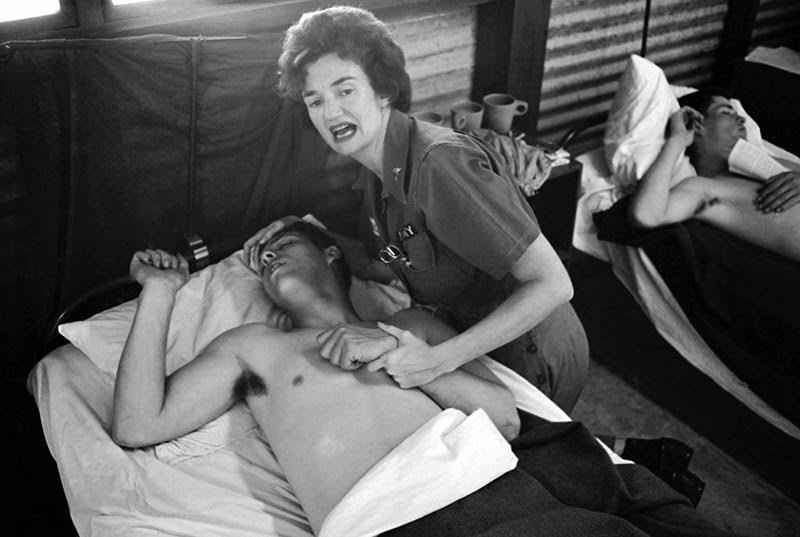
A nurse attempts to comfort a wounded U.S. Army soldier in a ward of the 8th army hospital at Nha Trang in South Vietnam on February 7, 1965. The soldier was one of more than 100 who were wounded during Viet Cong attacks on two U.S. military compounds at Pleiku, 240 miles north of Saigon. Seven Americans were killed in the attacks.
#2
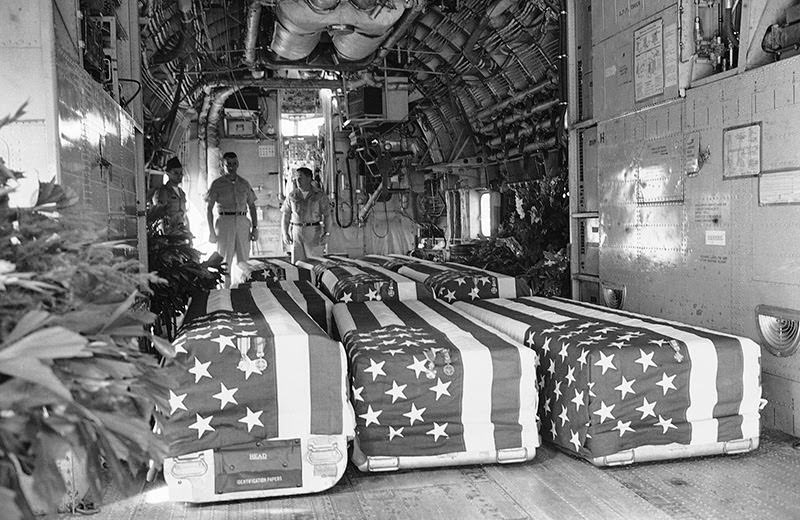
Flag-draped coffins of eight American Servicemen killed in attacks on U.S. military installations in South Vietnam, on February 7, are placed in transport plane at Saigon, February 9, 1965, for return flight to the United States. Funeral services were held at the Saigon Airport with U.S. Ambassador Maxwell D. Taylor and Vietnamese officials attending.
#3
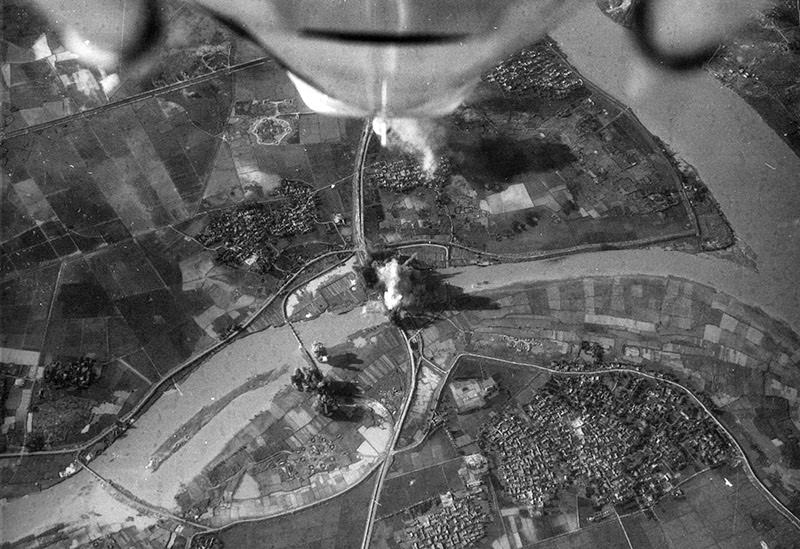
U.S. Navy Douglas A-4E Skyhawks from Attack Squadrons VA-163 Saints and VA-164 Ghost Riders attack the Phuong Dinh railroad bypass bridge, 10 kilometers north of Thanh Hoe, North Vietnam, on September 10, 1967. Note the attacking Skyhawk in the lower right and one directly left of the explosions on the bridge.
#4
#5
#6
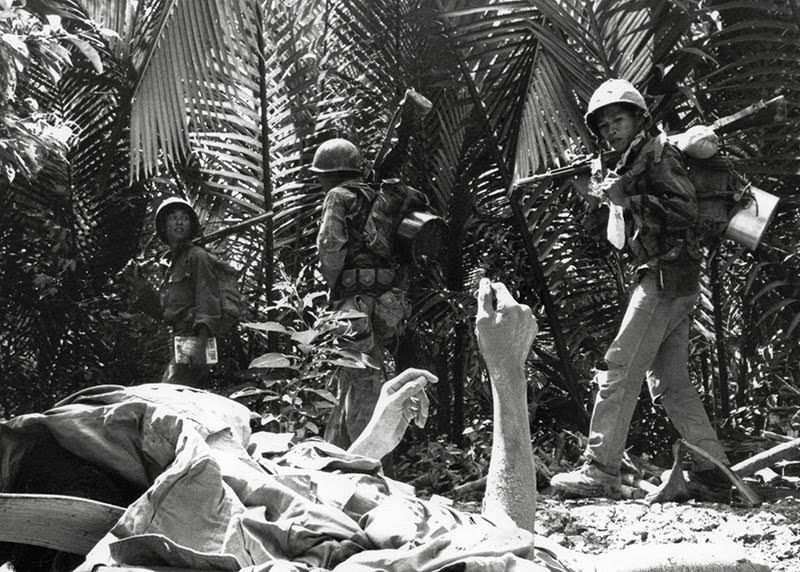
Partially covered, a dying Viet Cong guerrilla raises his hands as South Vietnamese Marines search palm groves near Long Binh in the Mekong Delta, on February 27, 1964. The guerrilla died in a foxhole following a battle between a battalion of South Vietnamese Marines and a unit of Viet Cong.
#7
#8
#9
#10
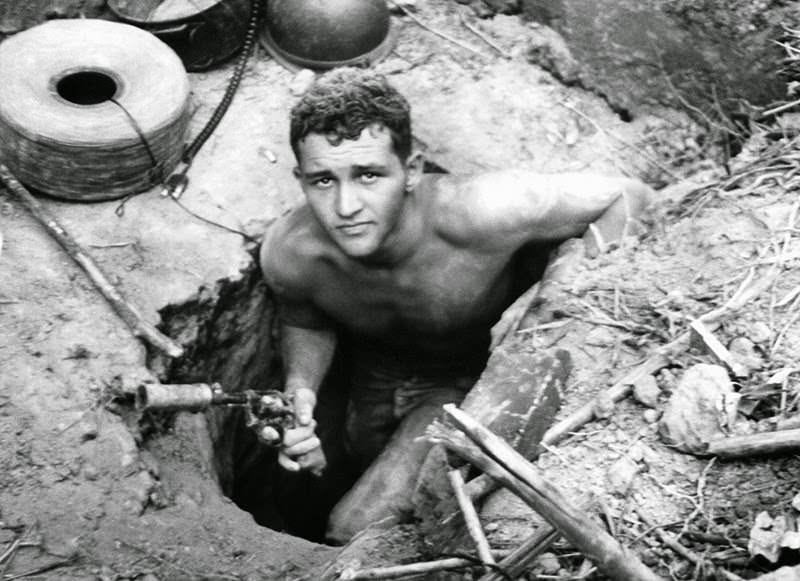
Sergeant Ronald Payne, 21, of Atlanta, Georgia, emerges from a Viet Cong tunnel holding his silencer-equipped revolver with which he fired at guerrillas fleeing ahead of him underground. Payne and others of the 196th light infantry brigade probed the massive tunnel in Hobo Woods, South Vietnam, on January 21, 1967, and found detailed maps and plans of the enemy. The infantrymen who explored the complex are known as “Tunnel Rats.” They were called out of the tunnels on January 21, and nauseating gas was pumped in.
#11
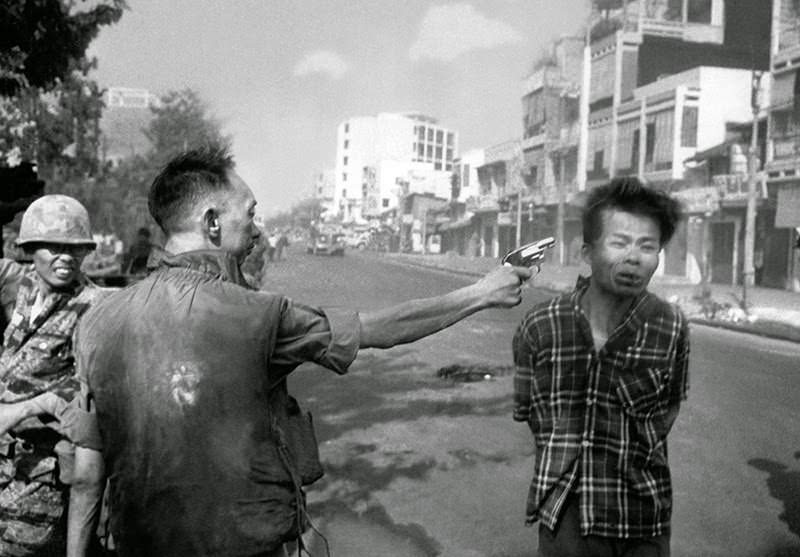
The South Vietnamese General Nguyen Ngoc Loan, chief of the national police, fires his pistol into the head of suspected Viet Cong officer Nguyen Van Lem (also known as Bay Lop) on a Saigon street on February 1, 1968, early in the Tet Offensive. Lem was suspected of commanding a death squad which had targeted South Vietnamese police officers that day. The fame of this photo led to a life of infamy for Nguyen Ngoc Loan, who quietly moved to the United States in 1975, opening a pizza shop in Virginia.
#12
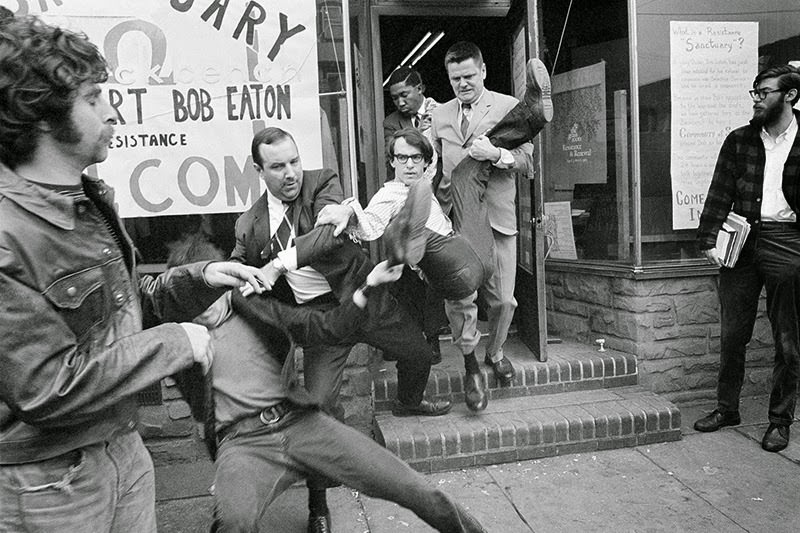
FBI agents carry Vietnam War draft resister Robert Whittington Eaton, 25, from a dwelling in Philadelphia on April 17, 1969, where Eaton had chained himself to 13 young men and women. The agent leading the way pushed one of the group who tried to block path to the sidewalk. At least six young persons were taken away with Easton.
#13
#14
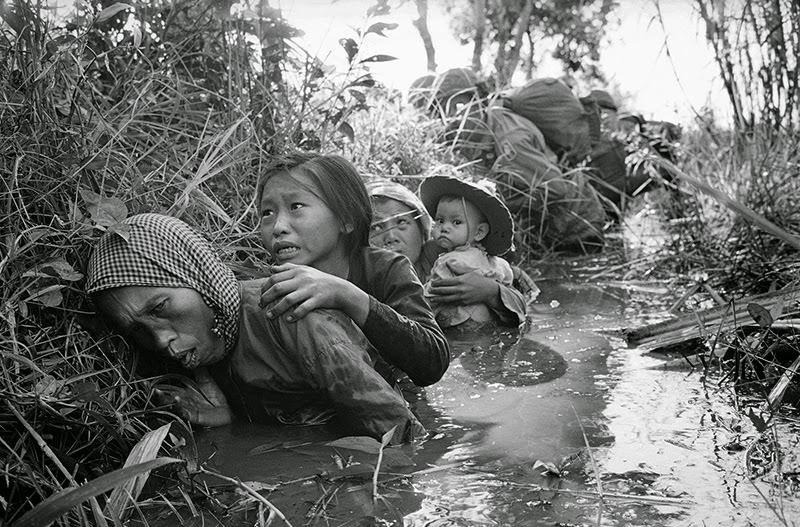
Women and children crouch in a muddy canal as they take cover from intense Viet Cong fire at Bao Trai, about 20 miles west of Saigon, on January 1, 1966. Paratroopers, background, of the U.S. 173rd Airborne Brigade escorted the South Vietnamese civilians through a series of firefights during the U.S. assault on a Viet Cong stronghold.
#15
#16
#17
#18
#19
#20
#21
#22
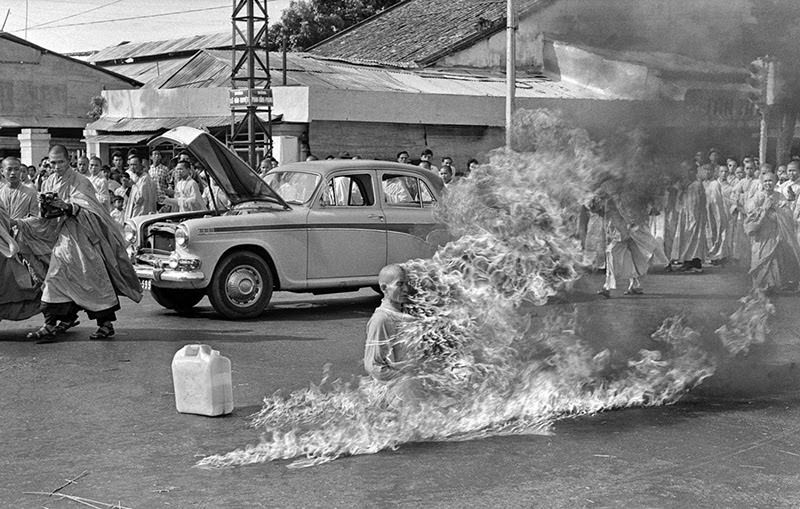
Thich Quang Duc, a Buddhist monk, burns himself to death on a Saigon street on June 11, 1963, to protest alleged persecution of Buddhists by the South Vietnamese government. President Ngo Dình Diem, part of the Catholic minority, had adopted policies that discriminated against Buddhists and gave high favor to Catholics.
#23
#24
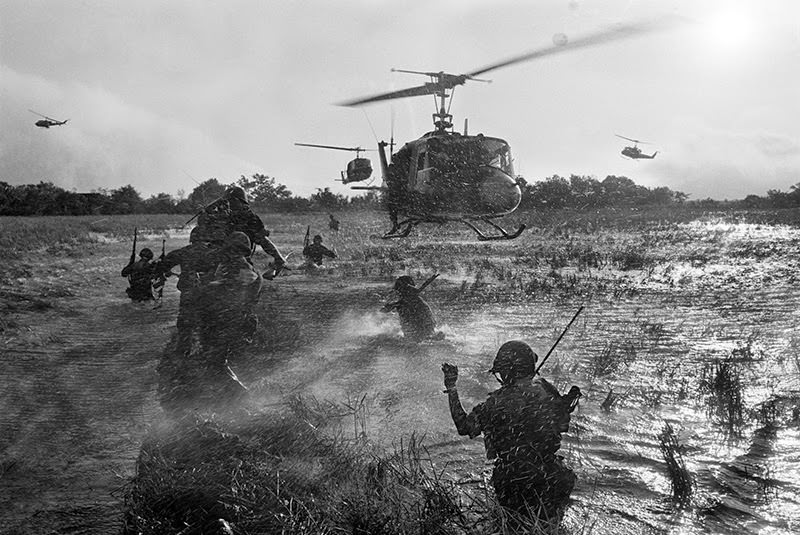
As U.S. “Eagle Flight” helicopters hover overhead, South Vietnamese troops wade through a rice paddy in Long An province during operations against Viet Cong guerrillas in the Mekong Delta, in December of 1964. The “Eagle Flight” choppers were loaded with Vietnamese airborne troops who were dropped in to support ground forces at the first sign of enemy contact.
#25
#26
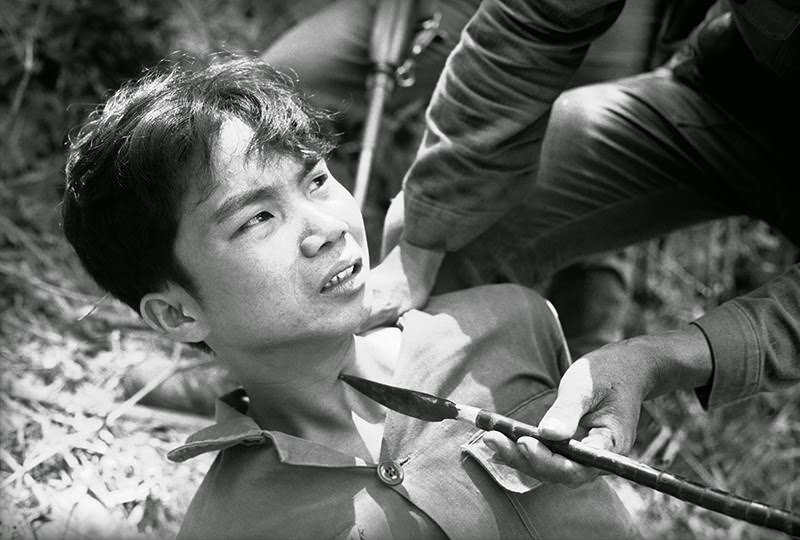
With the persuasion of a Viet Cong-made spear pressed against his throat, a captured Viet Cong guerrilla decided to talk to interrogators, telling them of a cache of Chinese grenades on March 28, 1965. He was captured with 13 other guerrillas and 17 suspects when two Vietnamese battalions overran a Viet Cong camp about 15 miles southwest of Da Nang air force base.
#27
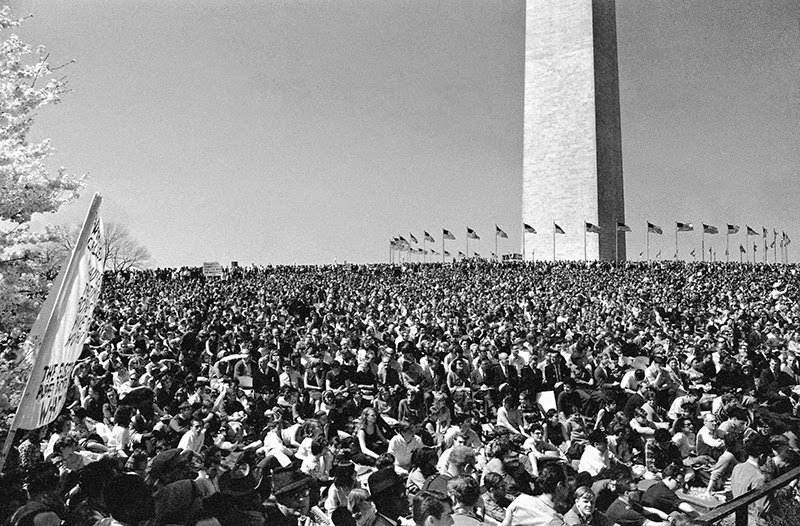
Thousands attend a rally on the grounds of the Washington Monument in Washington on April 17, 1965, to hear Ernest Gruening, a Democratic senator from Alaska, and other speakers discuss U.S. policy in Vietnam. The rally followed picketing of the White House by students demanding an end to Vietnam fighting.
#28
#29
#30
#31
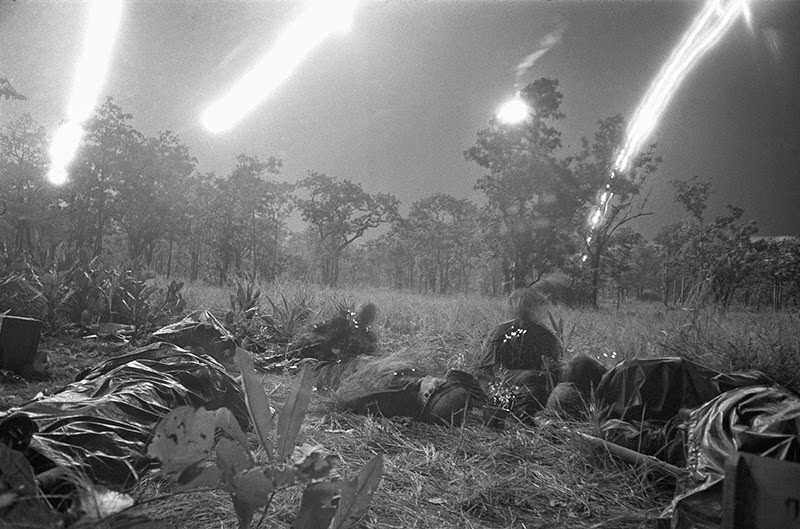
Flares from planes light a field covered with the dead and wounded of the ambushed battalion of the U.S. 1st Cavalry Division in the Ia Drang Valley, Vietnam, on November 18, 1965, during a fierce battle that had been raging for days. Units of the division were battling to hold their lines against what was estimated to be a regiment of North Vietnamese soldiers. Bodies of the slain soldiers were carried to this clearing with their gear to await evacuation by helicopter.
#32
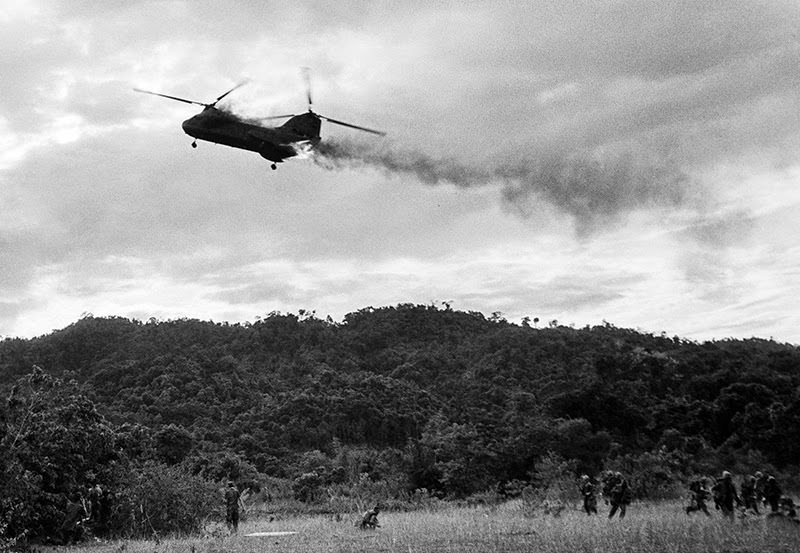
A U.S. Marine CH-46 Sea Knight helicopter comes down in flames after being hit by enemy ground fire during Operation Hastings, just south of the demilitarized zone between North and South Vietnam, on July 15, 1966. The helicopter crashed and exploded on a hill, killing one crewman and 12 Marines. Three crewmen escaped with serious burns.
#33
#34
#35
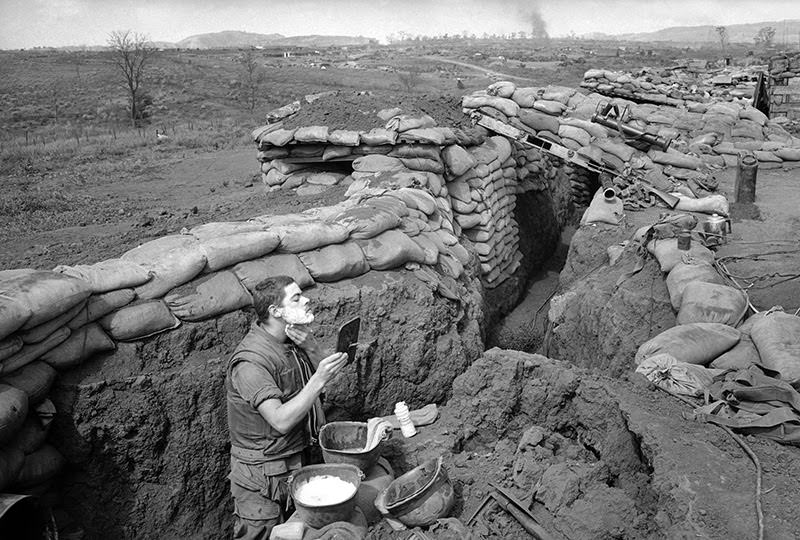
Marine Lance Corporal Roland Ball of Tacoma, Washington, wearing his flak vest, starts the day off with a shave in a trench at the Khe Sanh Base in Vietnam on March 5, 1968, which was surrounded by North Vietnamese regulars. Ball uses a helmet as a sink and a rear-view mirror taken from a military vehicle.
#36
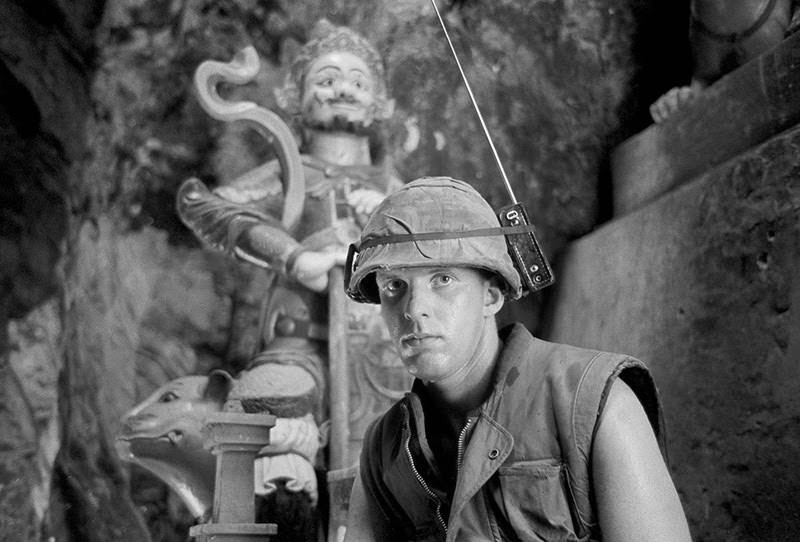
Marine Lance Corporal David L. Cruz tunes into the latest news on the Apollo moon shot on a helmet-mounted transistor radio while standing guard at Da Nang’s Marble Mountain, on July 17, 1969. In background is a tall Buddhist figure found in many limestone caves of the mountain.
#37
#38
#39
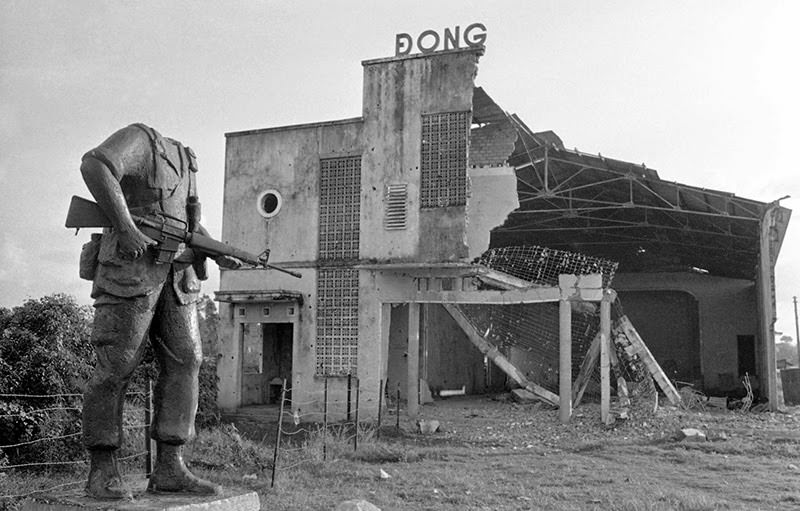
A beheaded statue of an American soldier stands next to a bombed-out theater near the district town of Cu Chi, northwest of Saigon, on December 13, 1972. The statue was placed by troops of the U.S. 25th Infantry Division before they were withdrawn from Vietnam two years earlier. Its head was lost in the explosion that destroyed the theater in background.
#40
#41
#42
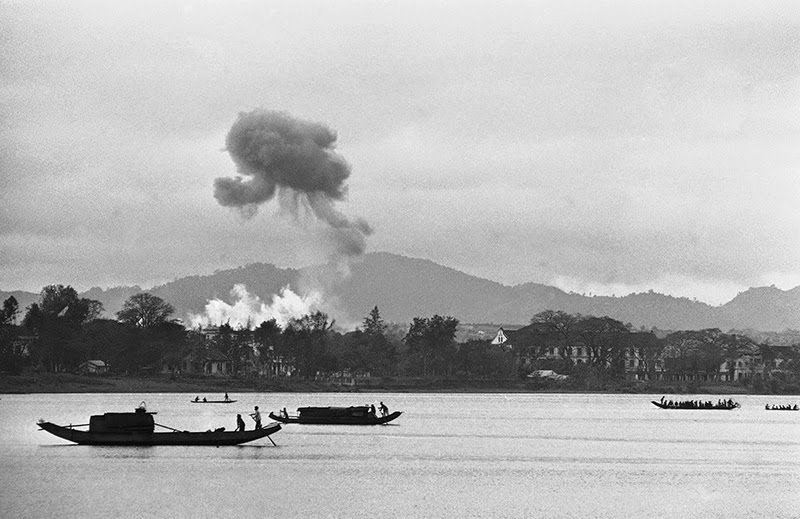
Napalm air strikes raise clouds into gray monsoon skies as houseboats glide down the Perfume River toward Hue in Vietnam on February 28, 1963, where a battle for control of the old Imperial City ended with a Communist defeat. Firebombs were directed against a village on the outskirts of Hue.
#43
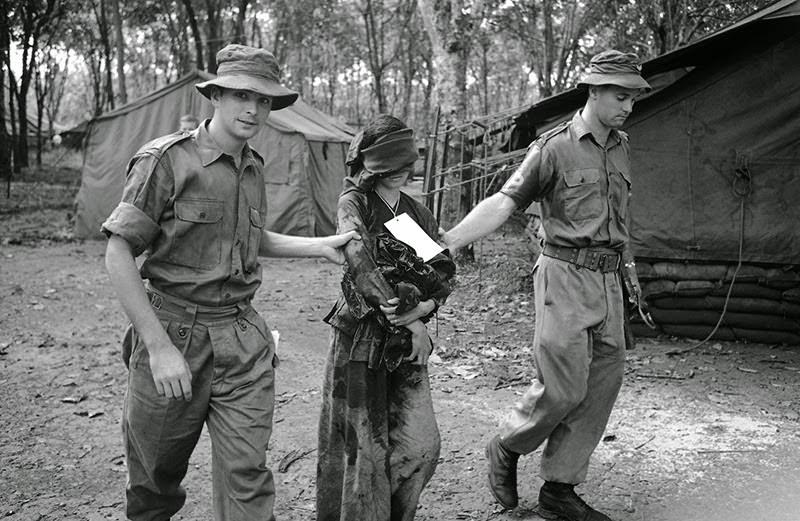
A Vietnamese girl, 23 years old, was captured by an Australian patrol 30 feet below ground at the end of a maze of tunnels some 10 miles west of the headquarters of the Australian task force (40 miles southeast of Saigon). The woman was crouched over a World War II radio set. About seven male Viet Cong took off when the Australians appeared—but the woman remained and appeared to be trying to conceal the radio set. She was taken back to the Australian headquarters where she told under sharp interrogation (which included a “waterprobe”; see her wet clothes after the interrogation) that she worked as a Viet Cong nurse in the village of Hoa Long and had been in the tunnel for 10 days. The Australians did not believe her because she seemed to lack any medical knowledge. They thought that she may have possibly been the leader of the political cell in Long Hoa. She was being led away after interrogation, clothes soaked from the “waterprobe” on October 29, 1966.
#44
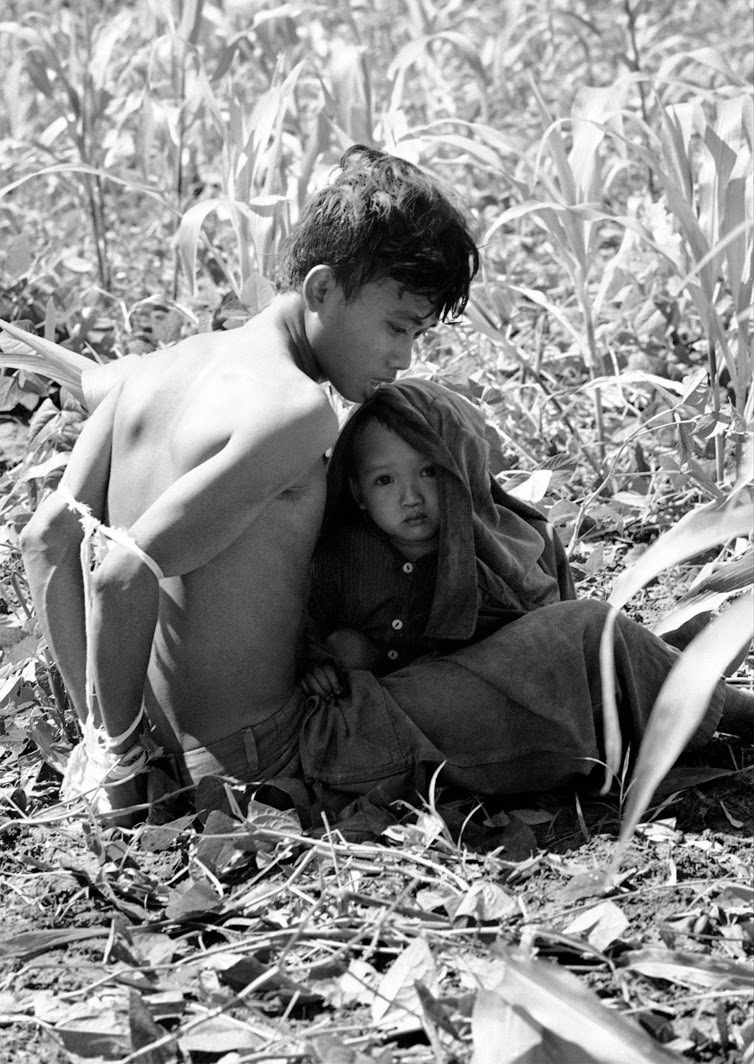
A Vietnamese child clings to his bound father who was rounded up as a suspected Viet Cong guerrilla during “Operation Eagle Claw” in the Bong Son area, 280 miles northeast of Saigon on February 17, 1966. The father was taken to an interrogation camp with other suspects rounded up by the U.S. 1st air cavalry division.
#45
#46
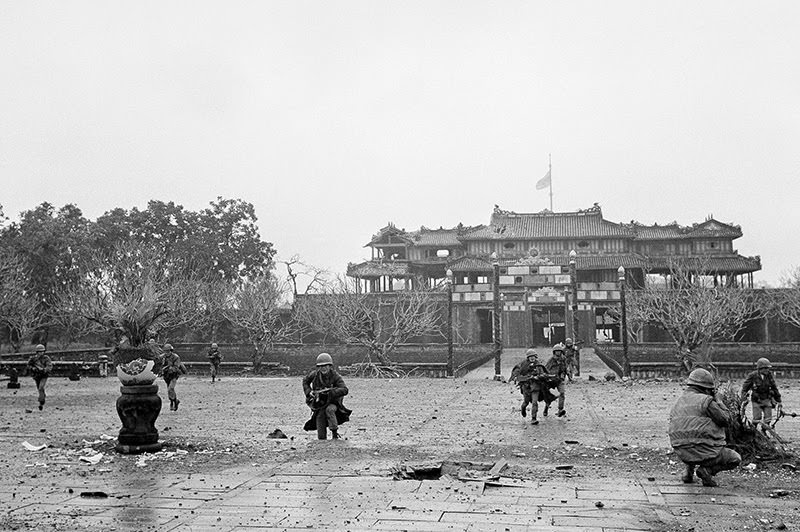
U.S. Marines and Vietnamese troops move through the grounds of the Imperial Palace in the old citadel area of Hue, Vietnam, on February 26, 1968, after seizing it from Communist hands. The heavy damage was the result of the artillery, air, and mortar pounding the area received for 25 days while the Viet Cong/NVA held the area.
#47
#48
#49
#50
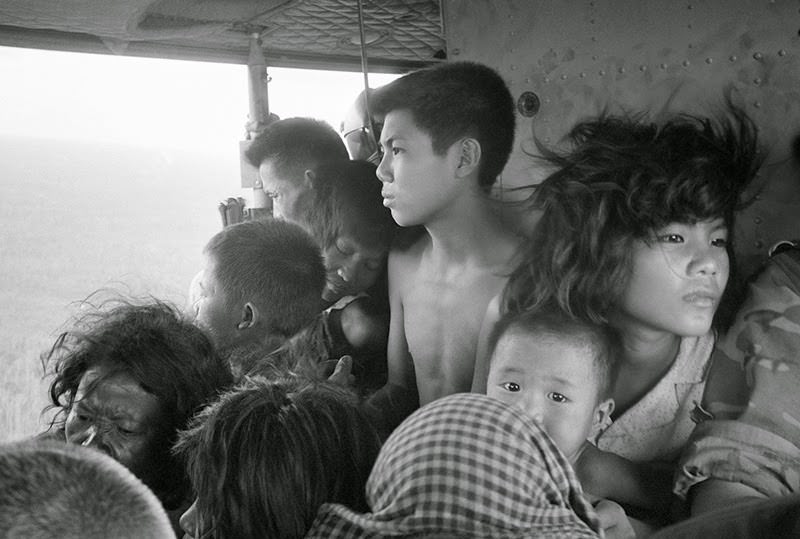
Vietnamese and Cambodian refugees crowd a U.S. helicopter which evacuated them from immediate combat zone of the U.S.-Vietnamese incursion into Cambodia on May 5, 1970. They were taken to a refugee reception center at the Katum Special Forces camp in South Vietnam, six miles from the Cambodian border.
#51
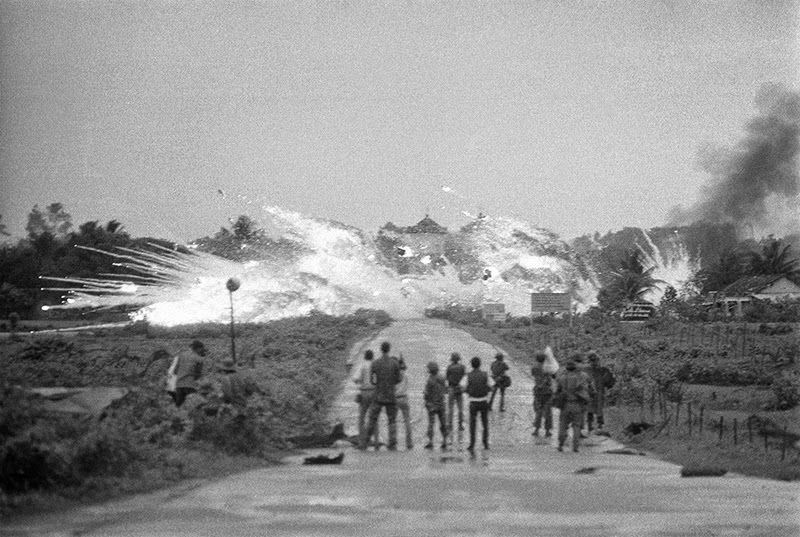
Bombs with a mixture of napalm and white phosphorus jelly dropped by Vietnamese AF Skyraider bombers explode across Route 1, amid homes and in front of the Cao Dai Temple in the outskirts of Trang Bang, on June 8, 1972. In the foreground are Vietnamese soldiers and news and cameramen from various international news organizations who watch the scene.
#52
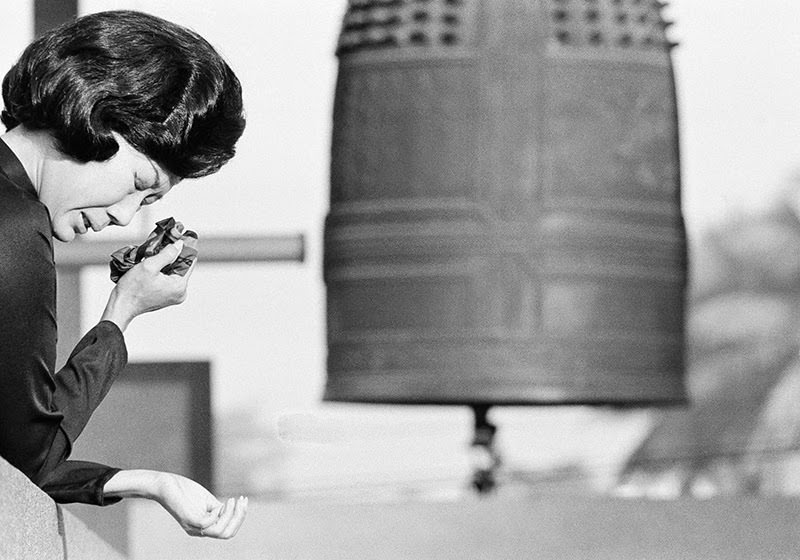
A South Vietnamese widow cries as a bell at a Saigon Buddhist pagoda tolls the ceasefire at 8 a.m., on Sunday, January 28, 1973, Saigon time. The United States had begun drastically reducing forces in the country, and, following the Paris Peace Accords of 1973, the last remaining American troops withdrew in March of 1973.
#53
#54
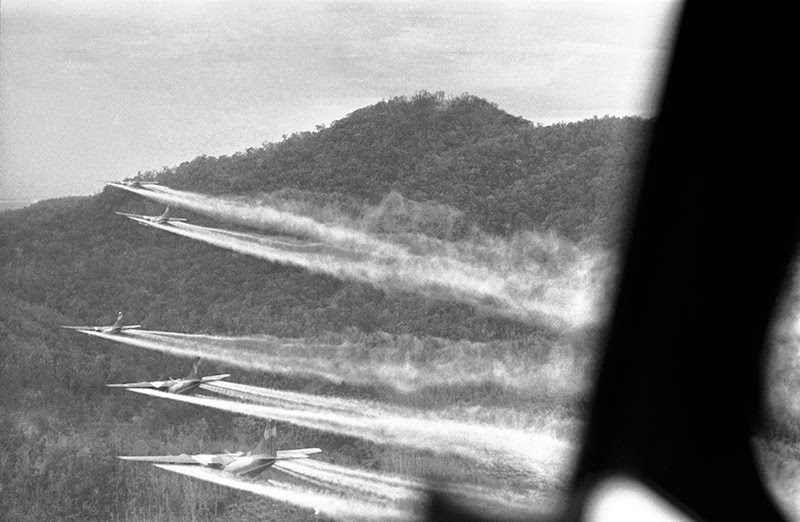
Flying 100 feet above the jungle hills west of Hue, five bulky C-123 “providers” cut loose a spray of chemical defoliant on August 14, 1968. The planes are flown by U.S. air force crews who have nicknamed themselves the “ranch hands.” The aircraft are specially equipped with huge 1,000-gallon tanks holding 11,000 pounds of herbicide. U.S. planes dropped millions gallons of chemical defoliant on Vietnam over the course of the war.Marines prepare their 105-mm Howitzers for action at the end of a day in which this dense jungle area west of Hue was chopped down and molded into a fire-support base for a sweep of the area on February 18, 1969.


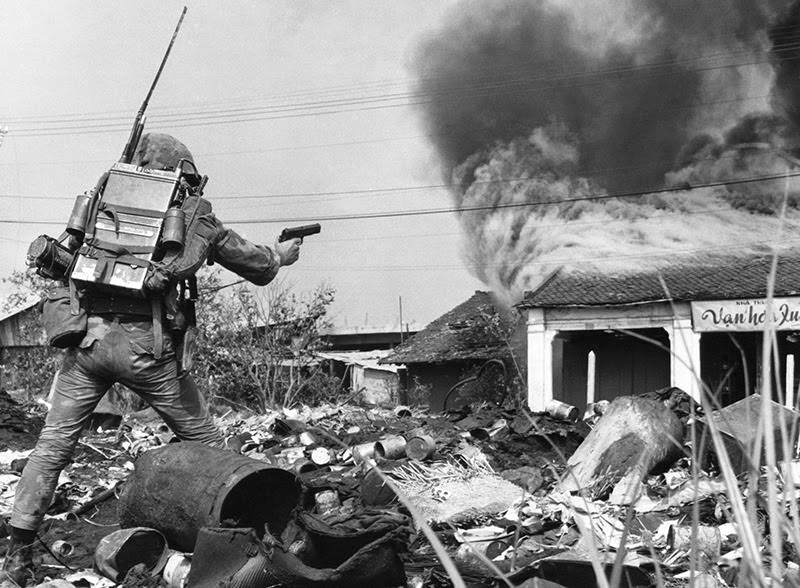
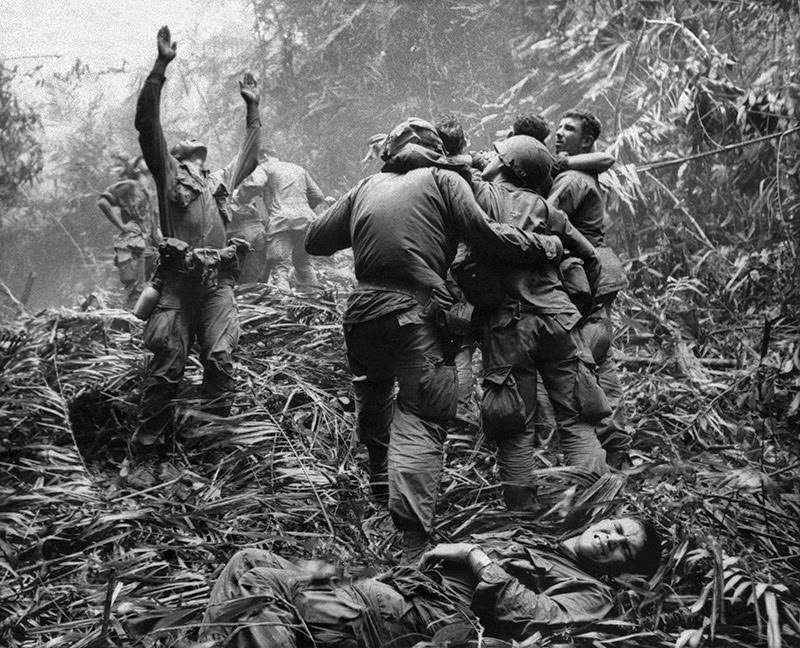
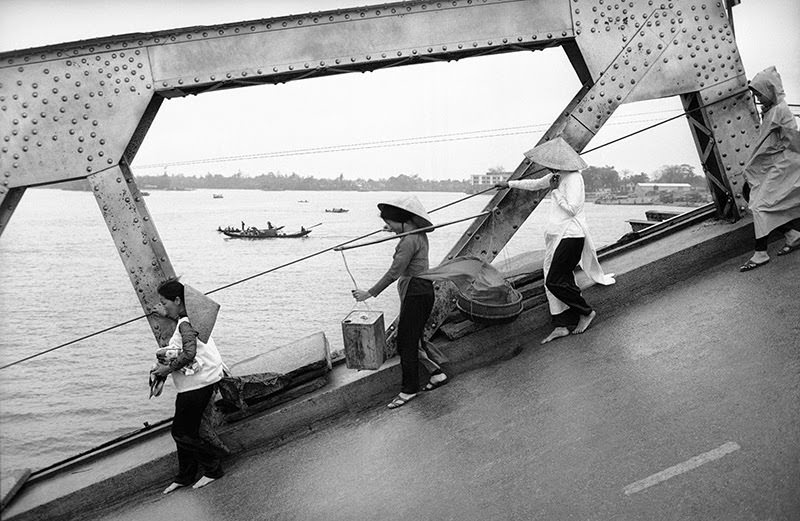
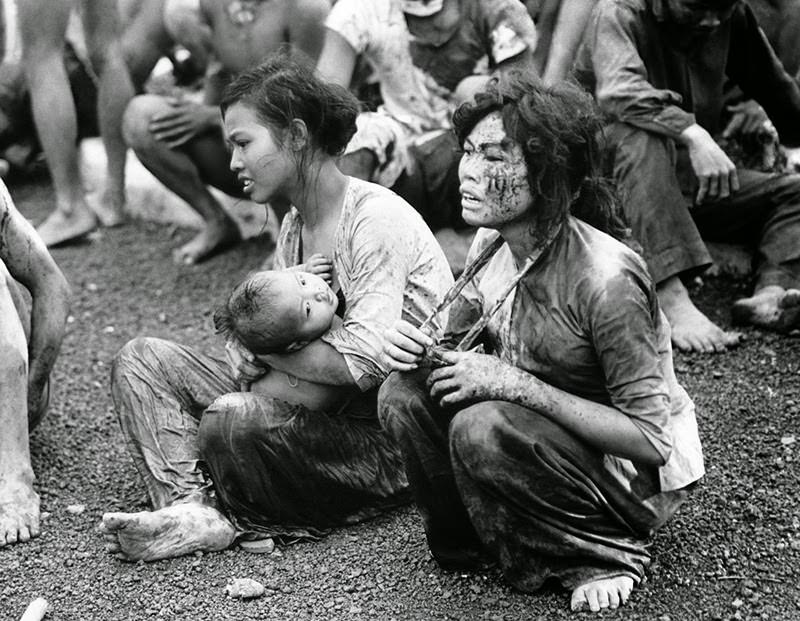
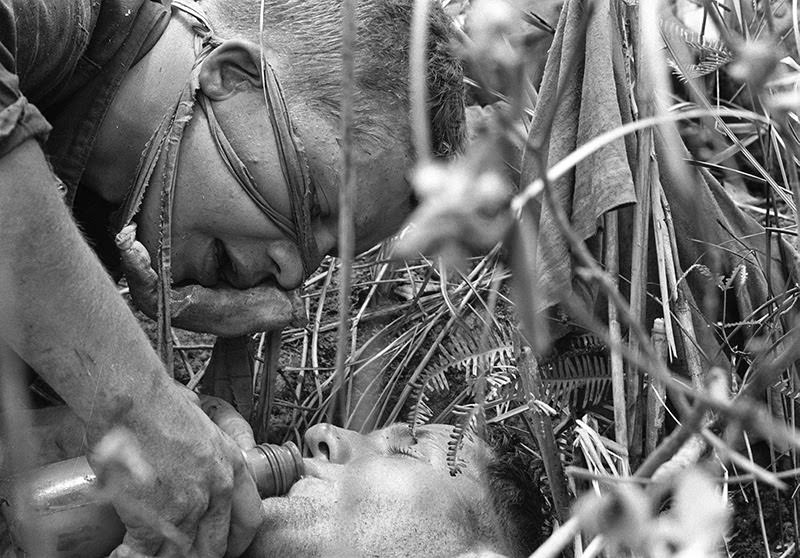
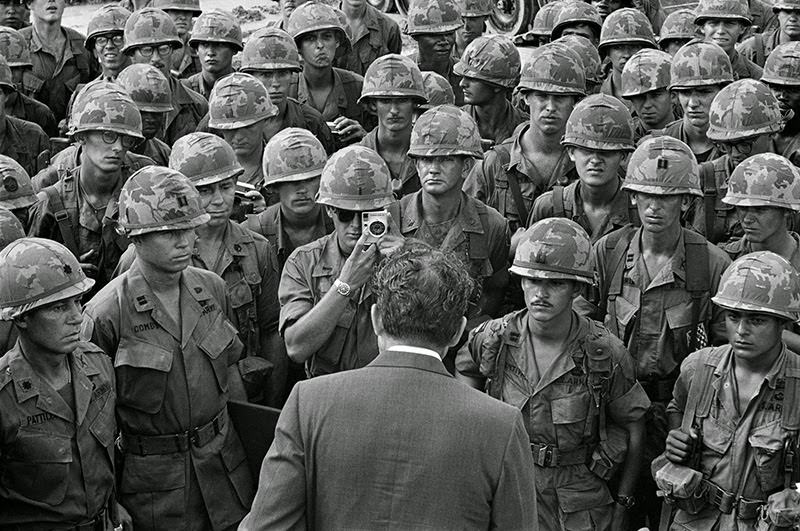
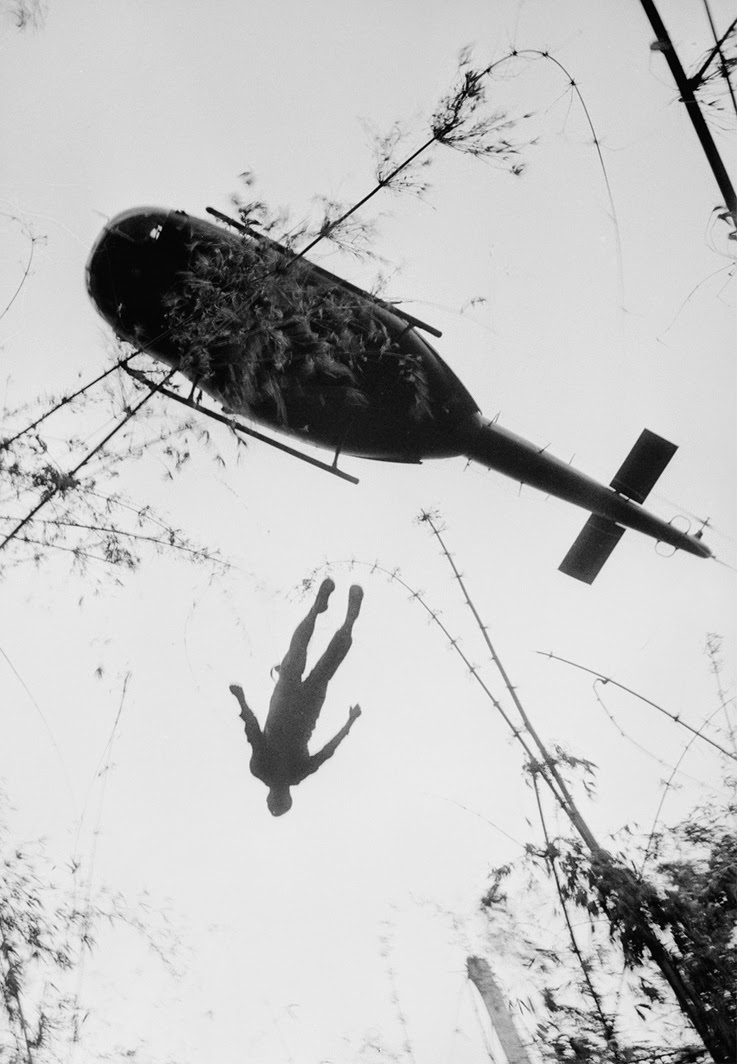
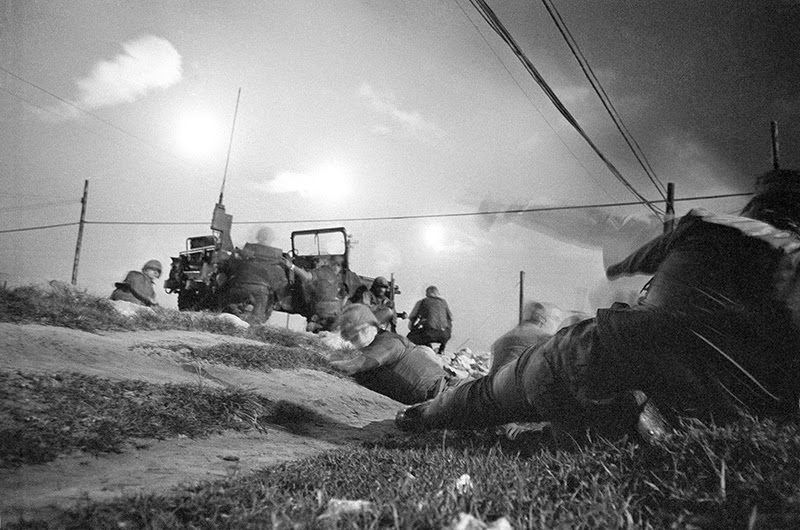
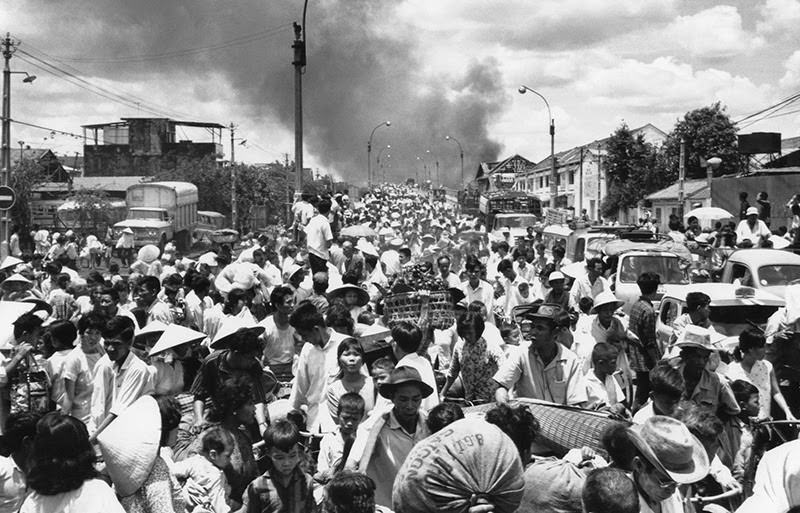
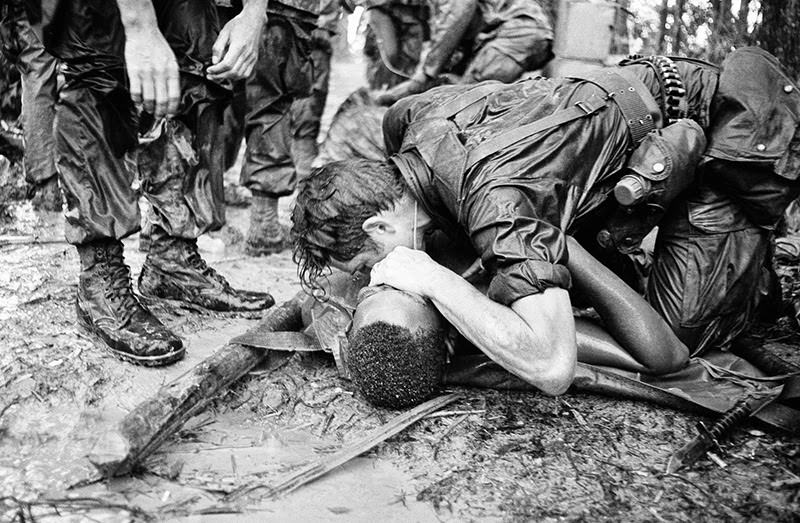
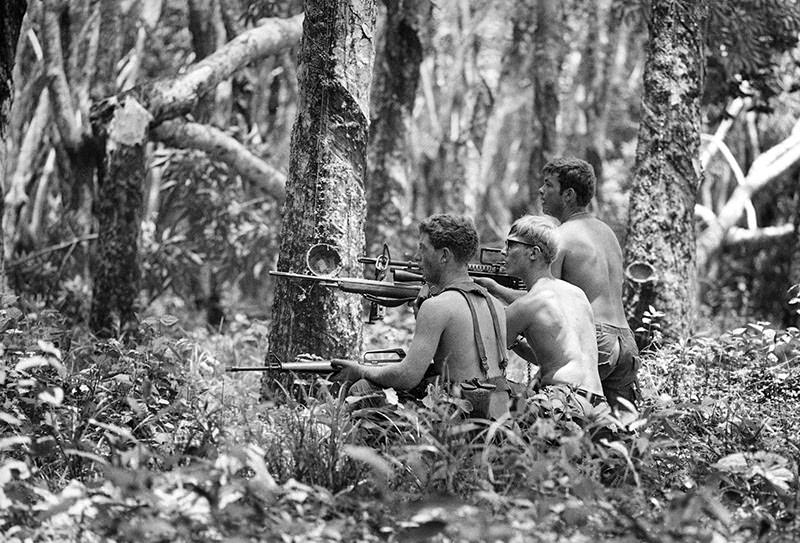
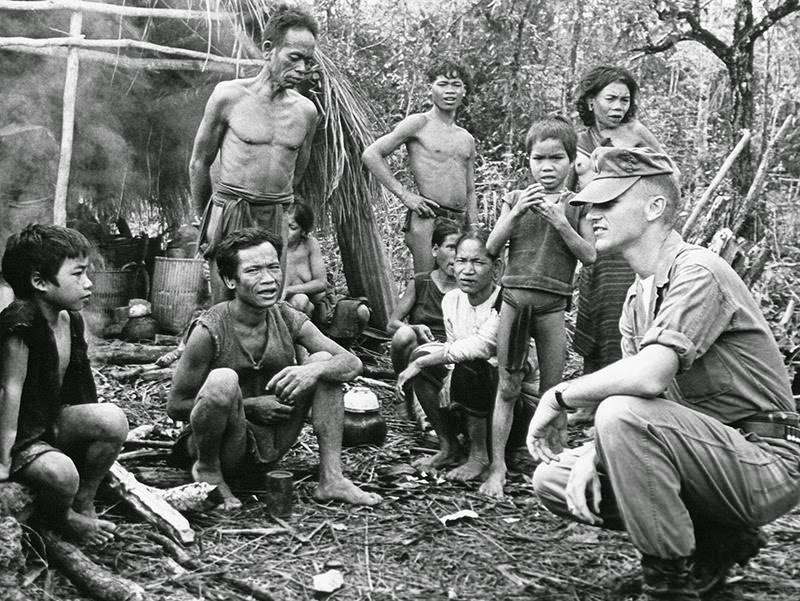
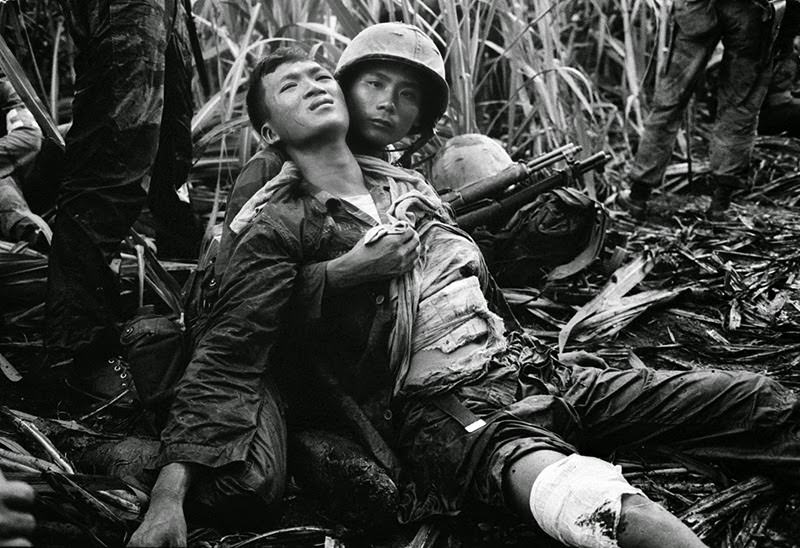
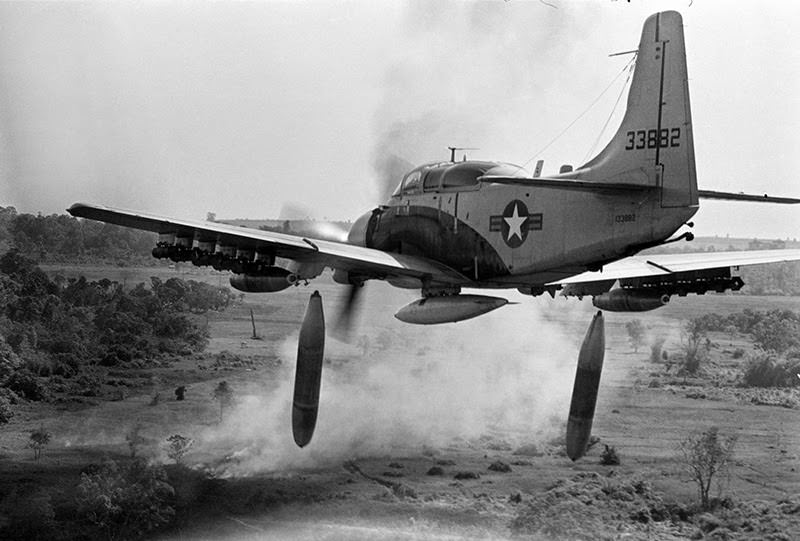
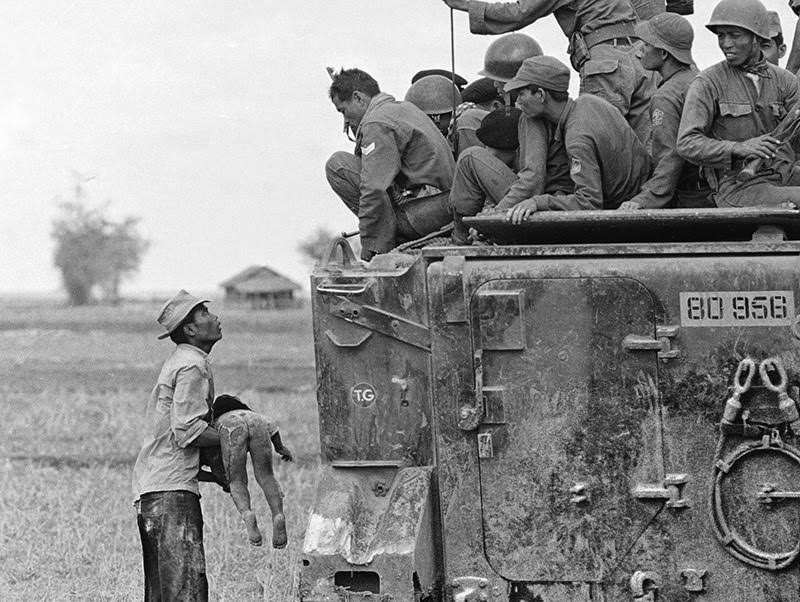
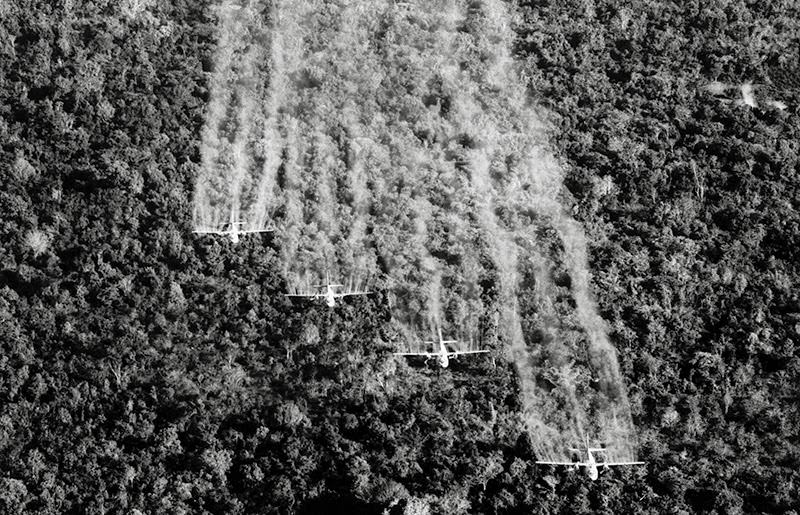
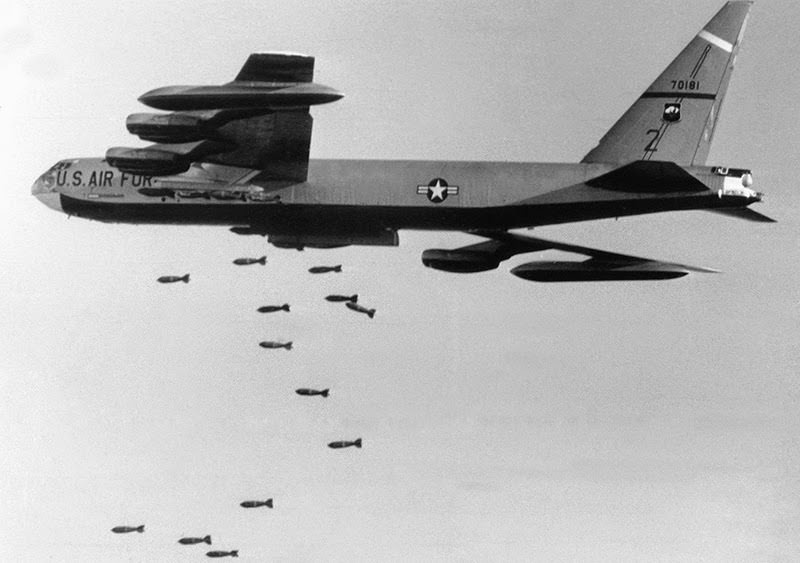
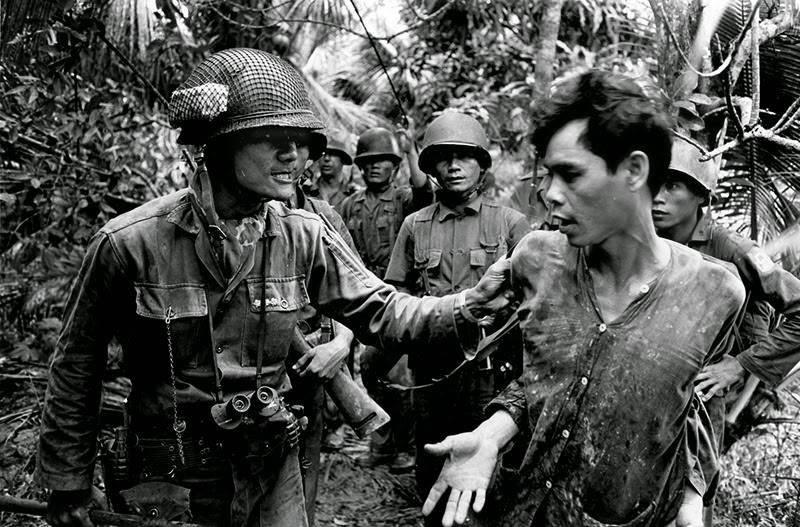
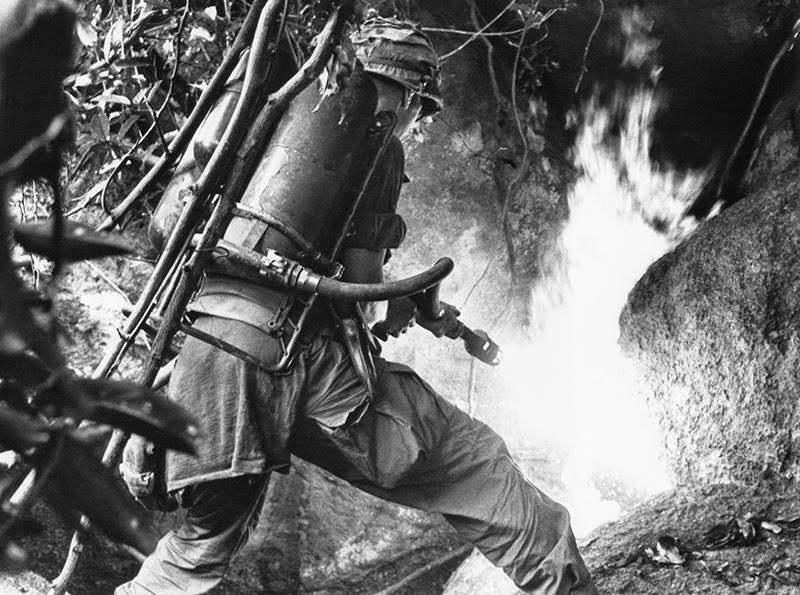
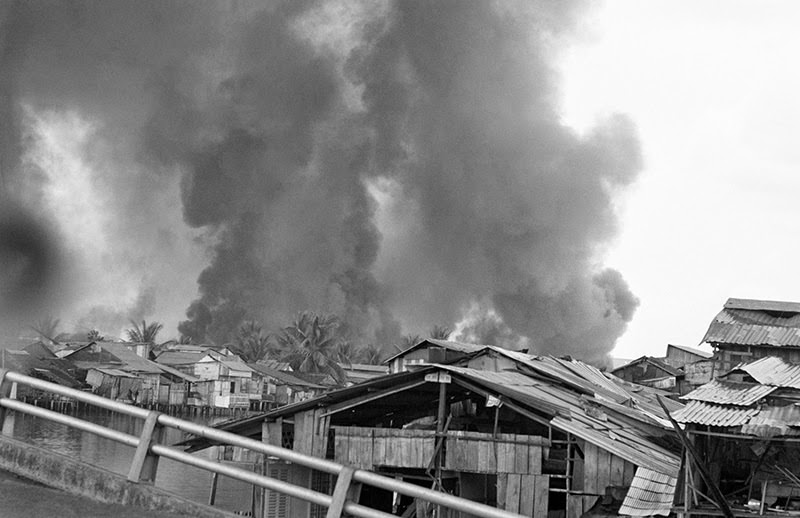
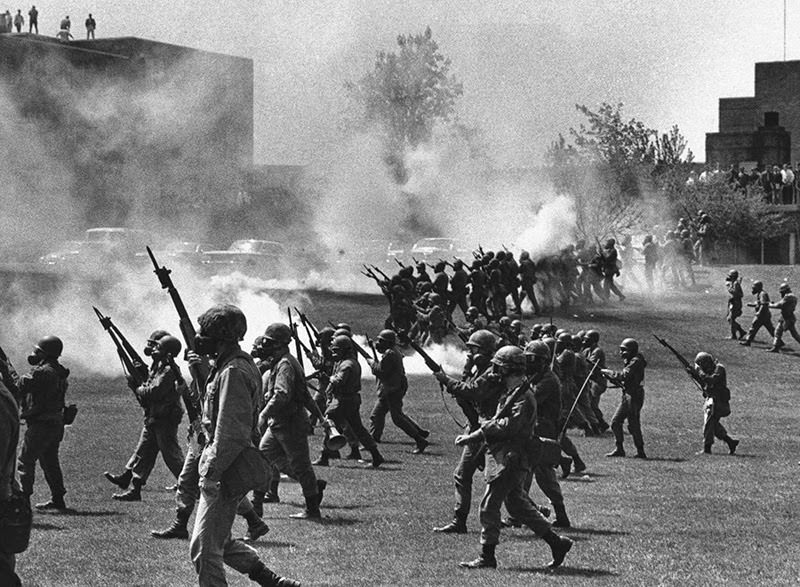
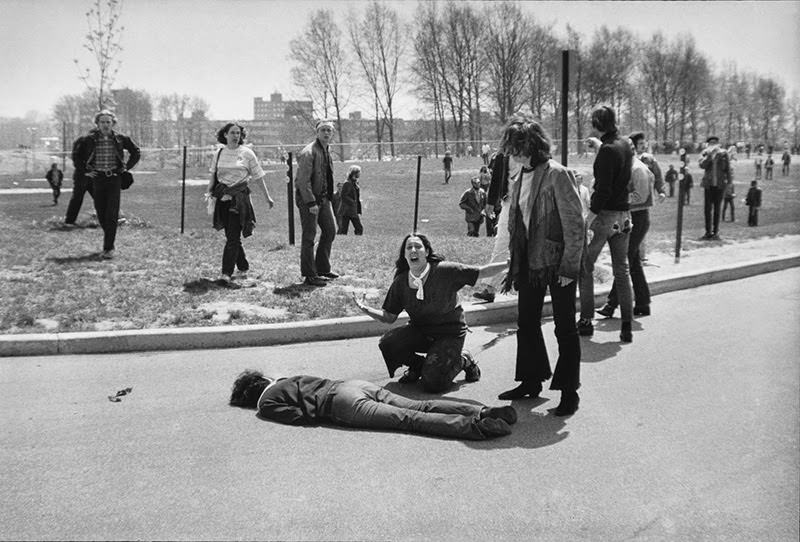
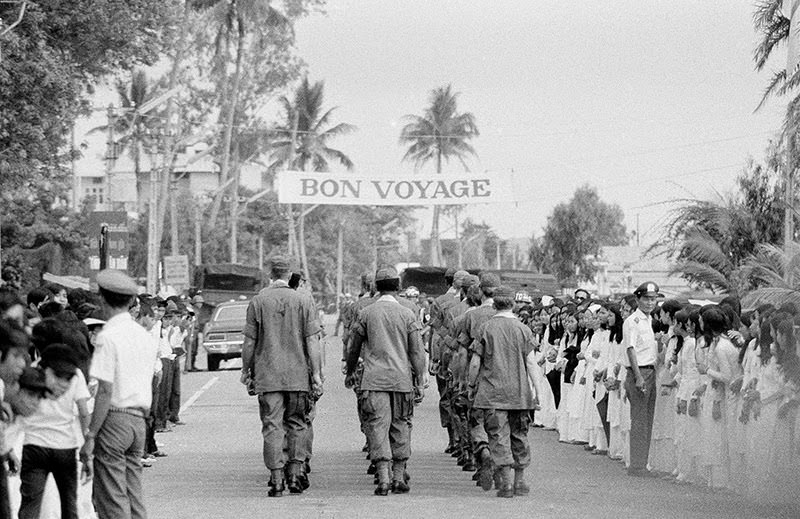
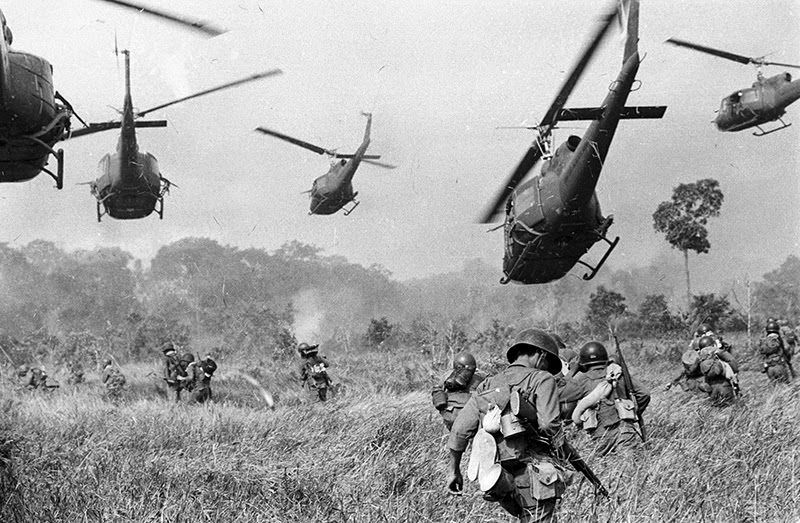
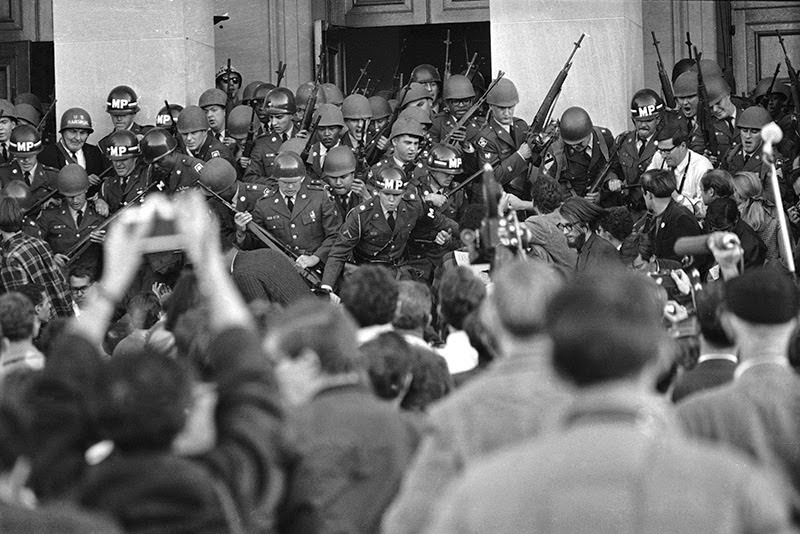
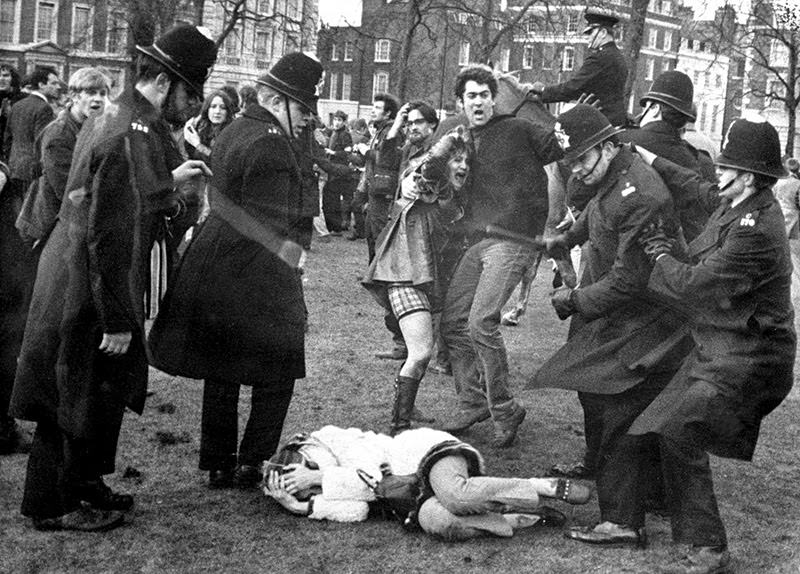
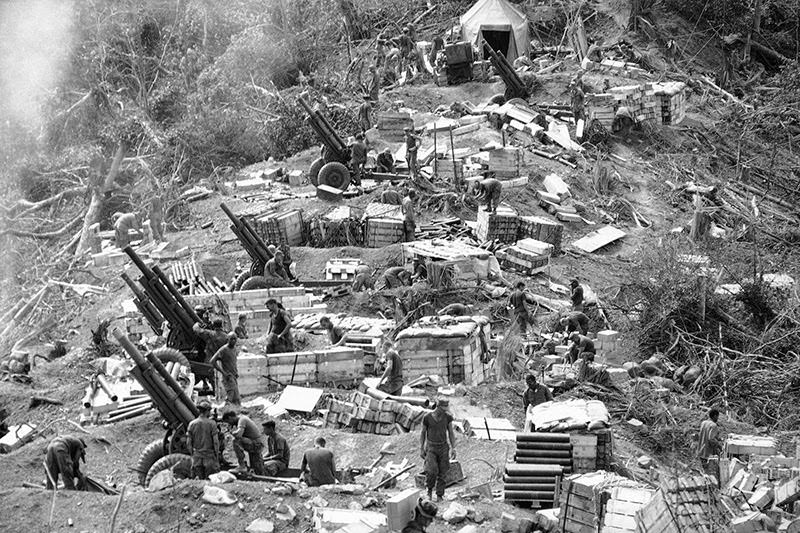
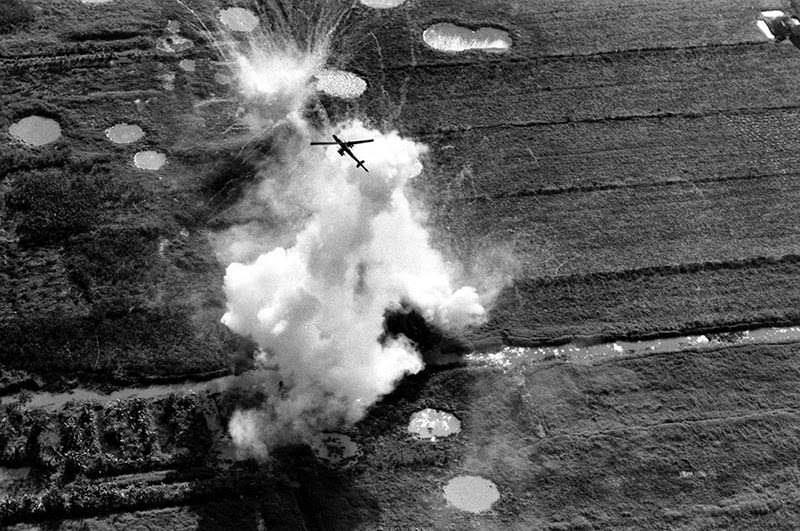
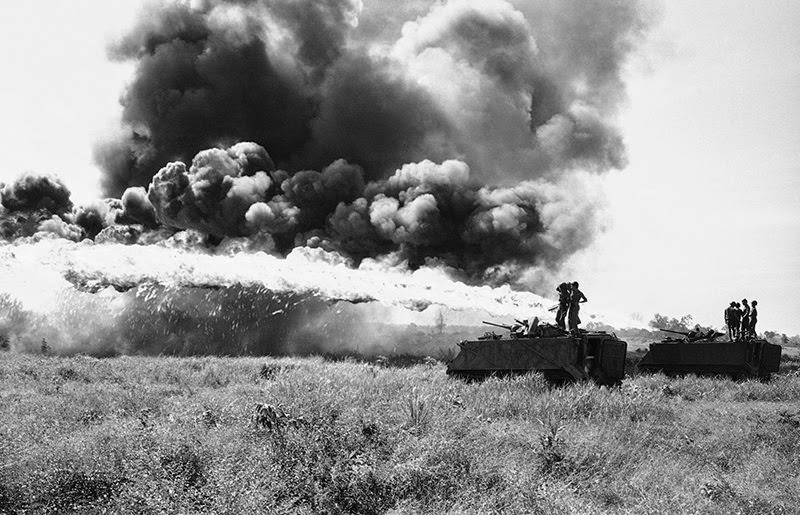
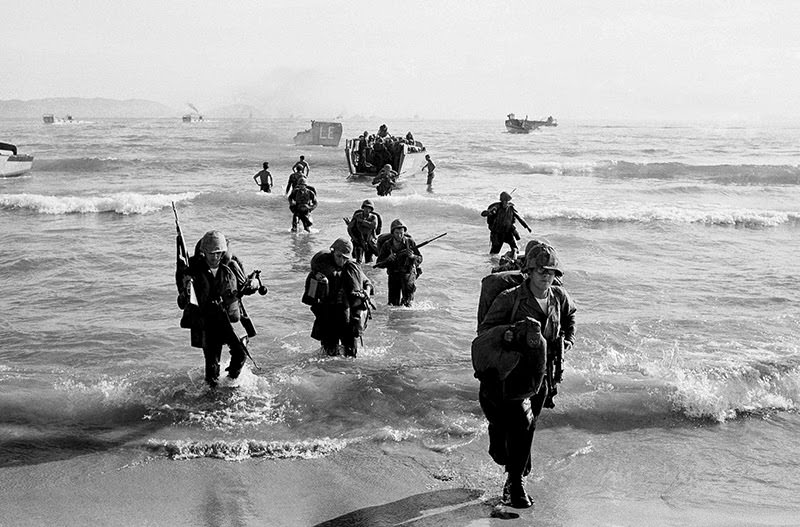

Aung, Moro
Sir, I hope this finds you doing great!!!
Thank you for the rare-to-be-seen-by-me photos of that terrible era my father was unfortunately involved.
Thank you for not only the photos, but even more so
More so the fantastic captions you took your time to write and provide detailed context! God bless you and take good care Sir!